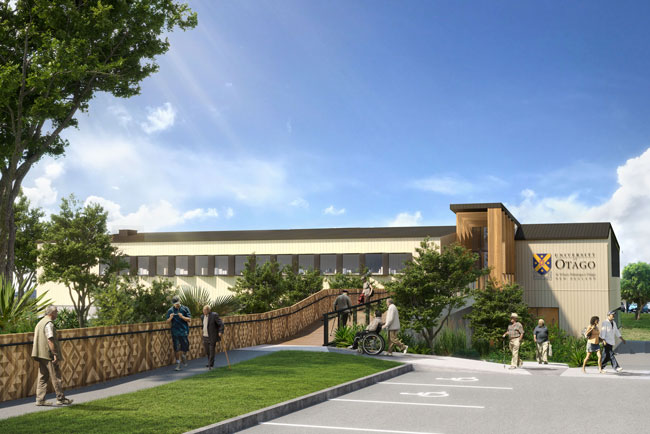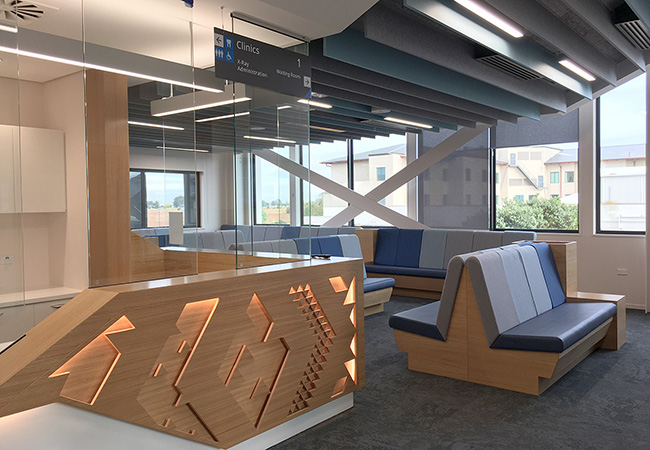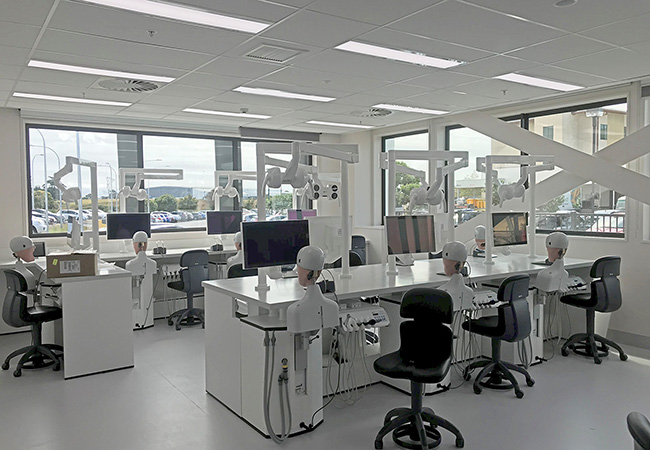
Construction of the University of Otago's Auckland dental teaching facility has come in ahead of time and under budget.
In anticipation of the official opening later this year, the construction team are celebrating a job well done.
“It's extremely satisfying,” says Project Director Jamie Cargill. “It's been a really good outcome.”
The University of Otago and the Counties Manukau District Health Board (CMDHB) signed a Memorandum of Understanding in November 2014 to achieve mutual goals of dental education for Faculty of Dentistry students and to provide dental services to patients of Counties Manukau.
The $28.2 million, two-storey, 32-chair building has been built adjacent to the Manukau Super Clinic on Great South Road. It will help to meet high health needs in the area while providing fifth-year students with wide-ranging learning opportunities.
The facility, made possible by a $10 million donation from businessman Graeme Hart and his wife Robyn, was completed more than a month early on 31 January.
With the University's project team managing the build remotely for the most part, it was crucial to have strong collaboration across all teams.
“There's the partnering culture that we try and set across the wider project team, and then there's the culture that the builder (Savory Construction) controls for the site, both have been excellent, which is why we have had such a great outcome,” Mr Cargill says.
“Everybody has put the project first and we have been able to quickly address anything that cropped up.”
It was also pleasing to bring the project in under budget, he says.
Through a partnership with the Te Ākitai iwi, a cultural narrative has been woven into the facility under the guidance of notable artist Johnson Witehira.
The narrative has been incorporated into the overall architecture and features such as the timber fins for the entryway, a balustrade on the bridge leading to building, the reception desk and a sandblasting pattern for the concrete footpath using repeating patterns of nihoniho (small teeth) and nihotaniwha (taniwha teeth).
Te Ākitai has kindly gifted the building two large stones (kōwhatu) which represent the local volcanos Matukutururu and Matukutureia and act as the first threshold of entry to the building.
The clinic will operationalise in stages with an initial group of students in the first semester of 2020 ahead of its official opening, Dr Peter Cathro explains.
“We want to embed good processes and will be ramping up to full capacity in 2022.”

The reception desk is one of many areas incorporating a cultural narrative.
Purpose
The new dental clinic aims to help meet high health needs, while providing students with wide-ranging learning opportunities in a diverse community that will increase their understanding of people from a range of backgrounds, Pro-Vice-Chancellor of the Division of Health Sciences Professor Paul Brunton says.
The Counties Manukau health board provides services to 11% of New Zealand's population, including 12% of New Zealand's Māori, 37% of New Zealand's Pacific people, and 21% of New Zealand's Asian people.
The project will strengthen relationships and partnerships with Māori and Pacific communities based on mutually beneficial goals incorporating patient care, research and education.
Not only will the Faculty of Dentistry regularly consult the community to find out what it needs from the clinics, the Faculty will also provide a wide range of outreach activities.
The clinic will follow the long-standing model operated successfully in Dunedin, where patients receive treatment provided by students under supervision at a highly accessible cost, he says.
Education
Final-year Bachelor of Dental Surgery students will be assigned to the Counties Manukau facility.
Having an Auckland base in an area home to a large number of oral healthcare professionals will also make it easier for them to access continuing education opportunities.
A simulation clinic in the new building could help meet both national and international demand for upskilling dentists as well, because Auckland is so accessible, Professor Brunton says.
Simulation clinics contain mannequin heads for training.

A simulation clinic in the University's new Auckland dental facility.
National centre
The University of Otago has been home to New Zealand's national centre of dentistry since 1907.
The Faculty of Dentistry in Dunedin carries out about 76,000 treatments annually in the city for the public from around the lower South Island.
The Faculty also includes the Sir John Walsh Research Institute and undergraduate and postgraduate programmes in dentistry, oral health and dental technology.